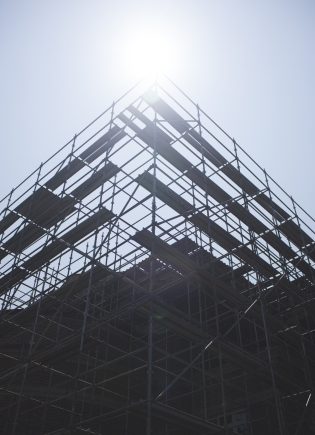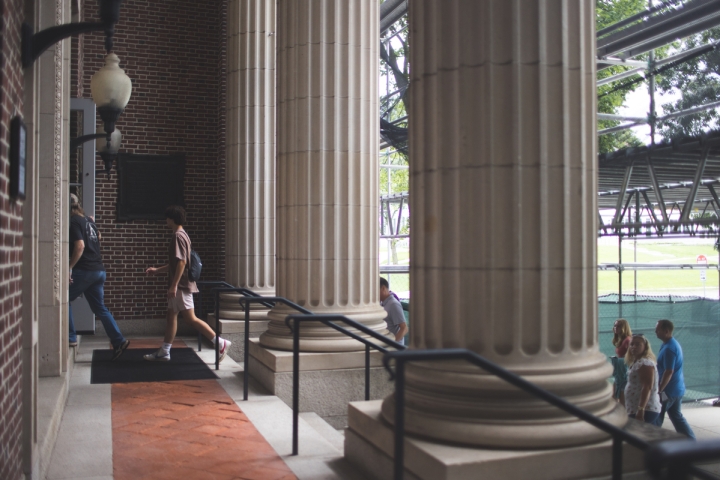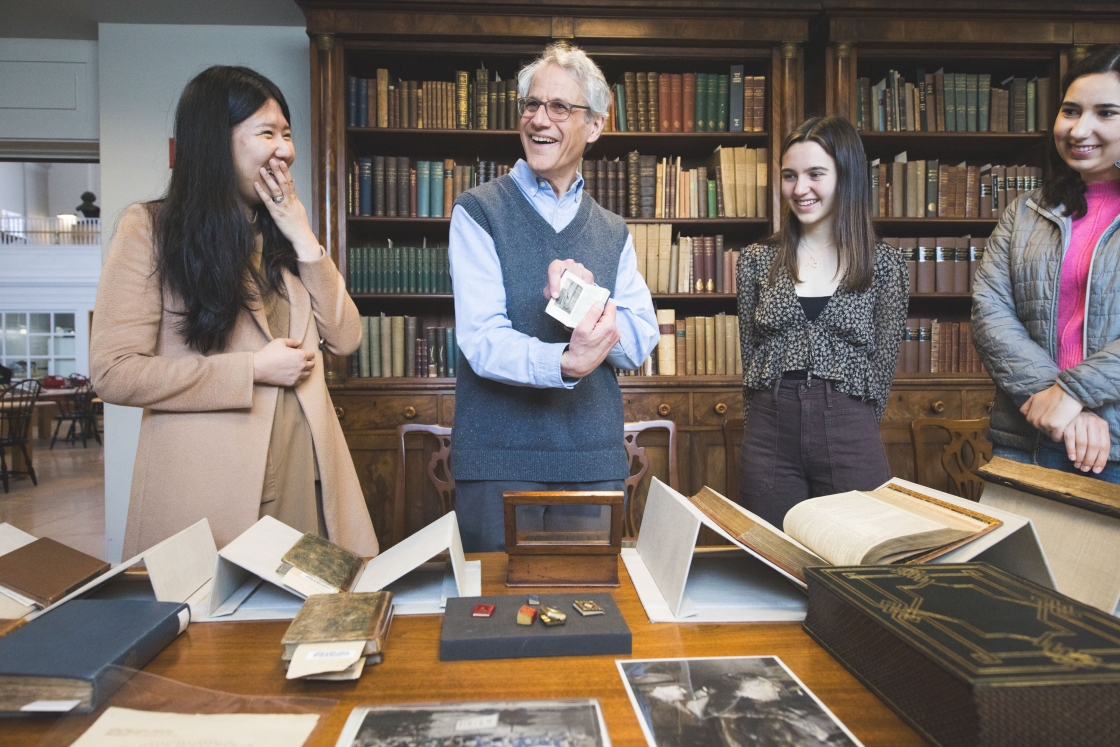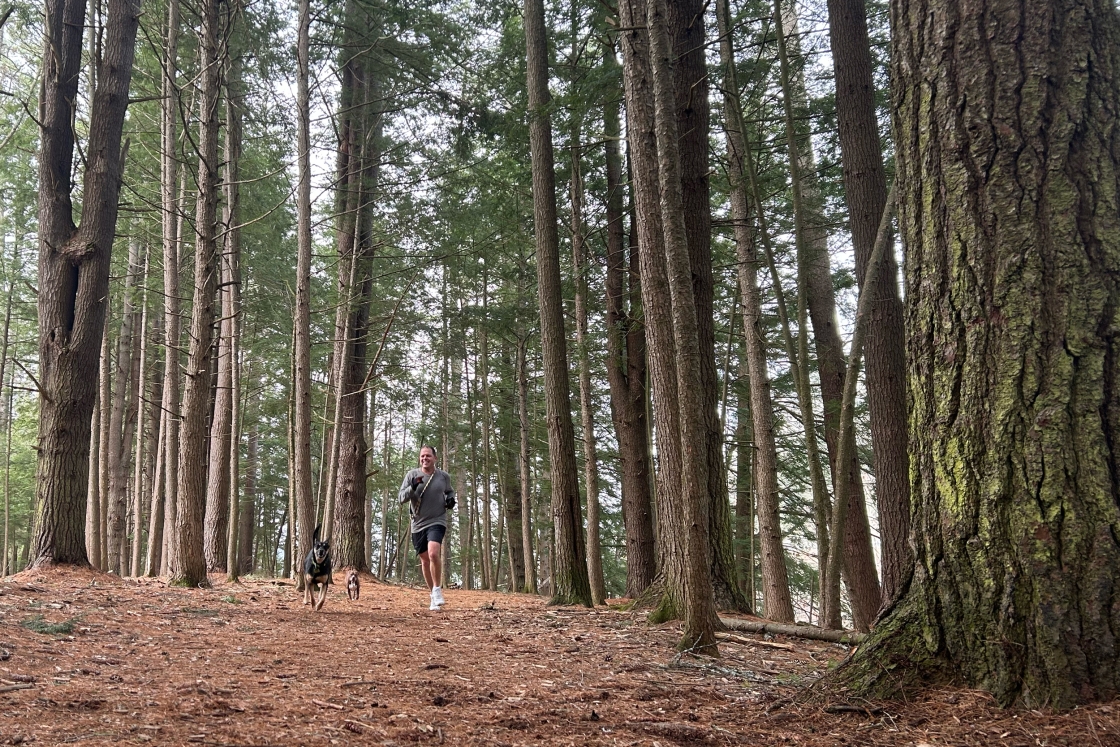If you’ve walked across the Green this summer, you may have noticed scaffolding going up at Dartmouth Library’s Rauner Special Collections Library.
The construction work is part of a $6.5 million project to replace and restore the 116-year-old building’s roof, copper detailing, cornices, and the decorative corbels supporting the cornices.
The scaffolding will be in place through December. In the spring, work will resume to repair brickwork, the back steps, and the loading dock.
The library will remain fully open during the project, says Dean of Libraries Sue Mehrer. “This work is absolutely critical to restore what is one of Dartmouth’s landmark buildings,” she says. “Things will get noisy, but library staff are doing everything they can to minimize disruption.”
The project team has been working closely with the library to halt noisy work during class sessions, says Jay Satterfield, head of special collections. “Every Friday we let the team know the scheduled class sessions for the coming week. They really have been great partners throughout the project.”
The work on Rauner is one of several construction projects on campus this summer—including the renovation and expansion of the Hopkins Center for the Arts, for which foundation work is well underway, and the ongoing renovation of East Wheelock House’s Andres and Zimmerman halls—part of a long-term plan to renovate the majority of undergraduate residence halls over the next 12 to 15 years.
The Rauner project is a priority because in recent years, damage to the cornices and corbels has presented a safety hazard, one that is being exacerbated by increasingly frequent freeze-thaw cycles likely caused by climate change, says Patrick O’Hern, senior director of project management services.
“Water gets in around the metal that holds the cornice together. When it’s warm during the day and freezes overnight, it expands and contracts, pushing pieces of cast stone off,” O’Hern says. “From our last survey a few years ago, we thought we would have five to 10 more years, but we don’t. If we don’t address this now, the repairs would cost us significantly more.”

The restoration work will change how the cornices and corbels are attached, making the connections more secure and less susceptible to water intrusion and rust damage. But the appearance of the building will remain the same, O’Hern says. The contractors are working with restoration experts to ensure that the project accurately preserves the original look of the building, he says.
Residence Hall Renewal
In Andres and Zimmerman halls, suites are being converted to singles and doubles—adding a total of nine new beds to each—and previously inefficient spaces are being converted to study nooks and student lounges.
The renovations include the addition of elevators to both buildings and updated heating and cooling systems that will be compatible with Dartmouth’s change from steam to hot-water heating.
Work on Andres Hall is nearly complete, and the building will be back online for undergraduate residents in time for the start of fall classes. Zimmerman Hall, where work began this summer, will reopen in fall 2024. O’Hern says the next residence halls slated for renewal are the Fayerweathers, which are part of the South House community. That project is currently in the design phase, pending approval from the Board of Trustees.
Interior work is currently being done at the Epsilon Kappa Theta sorority house at 15 Webster Ave., which Dartmouth owns. It will be completed for the start of classes in September.
Wi-Fi on the Green
Dartmouth is also installing Wi-Fi access points on lampposts around the perimeter of the Green. When connected for the start of the academic year, the service will be fast enough to support high-speed streaming and large file uploads on the Eduroam and Dartmouth Public networks, says Chief Technology Officer Felix Windt.
Windt says that the entire Green will have coverage, with faster service along the perimeter, where people naturally tend to congregate. Service will reach to the center of the Green, though it might be relatively slower there than in areas closer to the lamppost access points.
While the network will support up to about 500 active users at a time—more than the average occupancy of the Green on a typical day—it will not support thousands. For big events such as Commencement and the upcoming inauguration of President Sian Leah Beilock, Dartmouth will likely temporarily turn off access to Eduroam and Dartmouth Public on the access points.
“That way everyone’s phones won’t be trying to use Wi-Fi instead of falling back to cellular service” during those big events, Windt says.
Even so, the access points will allow for the creation of specialized networks to provide event organizers and communications teams access to Wi-Fi during those big events, or for Hop performers on the Green who need separate network connectivity, for instance.
“It will give us much more flexibility than we’ve had in the past,” Windt says.
Expanding Wi-Fi access to the Green is just the start of a push to provide outdoor Wi-Fi coverage around campus. Windt and his team are working with Dartmouth Student Government and the graduate and professional schools to identify priority locations.
But the project on the Green is an important milestone, Windt says. “This has been a highlight of my year. People have been clamoring for this for a long time, and we’re genuinely excited that we can finally provide it.”


